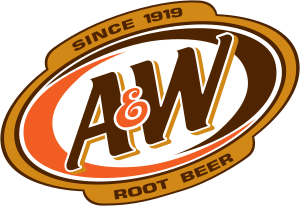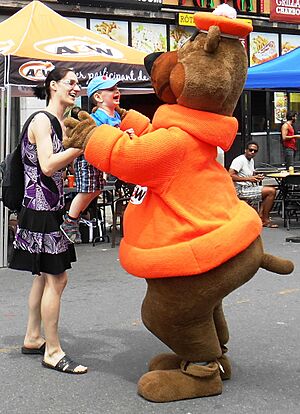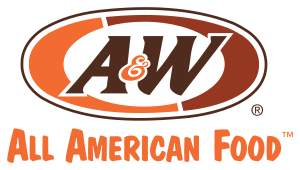- This page was last modified on 17 October 2025, at 10:18. Suggest an edit.
A&W Root Beer facts for kids
 |
|
| Type | Root Beer |
|---|---|
| Manufacturer | Keurig Dr Pepper (United States, rest of world) A&W Canada, Coca-Cola Canada Bottling Company (Canada) Coca-Cola Beverages Philippines (Philippine restaurant only) |
| Country of origin | United States |
| Introduced | 1919 |
| Related products | Barq's, Mug Root Beer, Dad's Root Beer, Hires Root Beer, A&W Cream Soda |
| Nutritional value per 8.1 fl oz / 1 cup / 240 ml | |
|---|---|
| Energy | 120 kcal (500 kJ) |
|
31
|
|
| Sugars | 31 |
| Dietary fiber | 0 |
|
0
|
|
| Saturated | 0 |
| Trans | 0 |
|
Protein
|
0
|
| Vitamins | Quantity
%DV†
|
| Vitamin A equiv. |
0%
0 μg |
| Vitamin C |
0%
0 mg |
| Minerals | Quantity
%DV†
|
| Calcium |
0%
0 mg |
| Iron |
0%
0 mg |
| Potassium |
0%
0 mg |
| Sodium |
2%
30 mg |
| Other constituents | Quantity |
| Cholesterol | 0 |
| †Percentages estimated using US recommendations for adults. | |
A&W Root Beer is a popular American root beer brand. It was started in 1919 by Roy W. Allen. You can find it mostly in the United States and Canada.
In 1922, Roy Allen teamed up with Frank Wright. They created the "A&W" name. This also led to the start of A&W Restaurants that same year. When it first came out, A&W Root Beer cost only five cents!
Today, Keurig Dr Pepper owns the A&W brand in the U.S. and most other countries. They let the A&W Restaurant chain use the brand. Different companies bottle and sell A&W Root Beer across the U.S. In Canada, A&W Food Services of Canada handles the restaurants and root beer. They work with the Coca-Cola Company for bottling and selling the drinks there. You can also find A&W Root Beer in places like Southeast Asia, Italy, Australia, and Chile.
Contents
The Story of A&W Root Beer
How A&W Root Beer Began
In 1919, Roy W. Allen opened a small stand in Lodi, California. He sold root beer using a special recipe he bought from a pharmacist. Soon, he opened more stands in places like Stockton and Sacramento. At these stands, "tray boys" brought drinks right to cars, which was a new idea! In 1920, Allen joined with Frank Wright, and that's how the A&W name was born.
Growing the A&W Brand
Roy Allen later bought out Frank Wright's share of the business. He got a special trademark for the A&W name. Then, he started selling franchises for his root beer. This made A&W one of the very first restaurant chains in the United States. Franchise owners could use the A&W name and logo. They bought the special root beer syrup from Allen. By 1933, there were 170 A&W franchises.
During World War II, it was tough for businesses to find workers and sugar. But after the war, things got better. By 1950, more than 450 A&W Root Beer stands were open. That year, Roy Allen retired. He sold the business to Gene Hurtz, who started the A&W Root Beer Company. The first A&W Root Beer place in Canada opened in 1956. By 1960, there were over 2,000 A&W restaurants!
New Owners and New Products
In 1963, the J. Hungerford Smith Company bought A&W. This company had been making Allen's root beer syrup since 1921. That same year, the first A&W restaurant outside North America opened in Guam.
In 1971, a new company called A&W Distributing Co. was created. This company started selling A&W Root Beer in stores across the country. They even made sugar-free, low-sodium, and caffeine-free versions. In 1974, A&W introduced its famous mascot, "The Great Root Bear". This friendly bear became a symbol for the brand.
In the late 1970s, A&W Restaurants was formed to manage the restaurant franchises. In 1983, a group of investors bought A&W Root Beer. They spent a lot of money on advertising to help the brand grow.
In 1986, A&W Cream Soda and A&W Diet Cream Soda were launched. The next year, A&W Sugar-Free was renamed Diet A&W. The company also bought other drink brands like Squirt and Vernors.
In 1993, A&W Beverages became part of Cadbury Beverages. Later, in 2008, the U.S. beverage part became Dr Pepper Snapple Group.
In July 2017, A&W Canada changed its root beer recipe. They stopped using high fructose corn syrup and added cane sugar, sarsaparilla root, licorice, birch bark, and anise. To celebrate, A&W Canada gave away free root beer on July 22, 2017. In November 2020, Diet A&W was renamed A&W Zero Sugar.
A&W Drink Varieties
A&W offers several different kinds of drinks:
- A&W Zero Sugar: This version was first called A&W Sugar-Free in 1974. It was renamed Diet A&W in 1987 and then A&W Zero Sugar in 2020.
- A&W Cream Soda: This creamy soda and its diet version were introduced in 1986.
- A&W Floats: In 2008, A&W started offering ready-to-drink floats.
- A&W TEN: This is a low-calorie root beer that came out in 2013.
Advertising Campaigns
A&W has had many memorable advertising campaigns over the years.
"Now New York Has Everything"
In 1978, A&W launched a campaign called "Now New York Has Everything." This was to celebrate A&W Root Beer finally being sold in the New York City area. Even though A&W was a top root beer brand, it wasn't available everywhere. The ads showed people who had moved to New York and missed A&W Root Beer.
Fun and Famous Faces
In the 1980s, A&W ads sometimes looked like beer commercials. They even featured lumberjacks! Later, in 1991, A&W started using famous actors from old commercials. For example, Dick Wilson (who played Mr. Whipple in Charmin ads) appeared in a cream soda commercial. Jan Miner (Madge from Palmolive ads) was in the zero sugar ad. Mr. T also appeared in a commercial for the main root beer. In 1992, David Leisure (who played Joe Isuzu) also starred in A&W ads.
In 1992, A&W started using the "frosty mug taste" slogan. In 1999, they launched the "It's Good to be Thick Headed" campaign. These ads were often funny and aimed at male sports fans. However, by 2001, A&W decided to make new ads for a wider audience, as they found that teen girls also loved the drink.
Promotions and Fun Contests
A&W has held many fun promotions.
- A&W once teamed up with actor Jim Belushi to offer a special trip to Los Angeles. The winner got a VIP pass to an "A&W Ultimate All-American Cookout and Concert."
- For its 100th anniversary, A&W gave away free two-liter bottles of root beer. To get one, people had to take the "Family Fun Pledge." This pledge asked families to go "technology-free for one hour every Friday night" during the summer.
The Great Root Bear
The Great Root Bear, also known as Rooty, became the mascot for A&W Root Beer in 1973.
In Canada, Rooty starred in many TV commercials for A&W restaurants. His theme song was a catchy tune with a tuba, called "Ba-Dum, Ba-Dum." This song was even released as a single! The famous Canadian composer Robert Buckley helped create the song.
Around 2011, A&W started using Rooty again, especially on their websites and social media.
A&W Restaurants
After Roy Allen bought out Frank Wright, he started selling franchises for his root beer. He made money from a small fee and by selling his special root beer syrup. For a long time, there wasn't a standard food menu for all A&W restaurants. But by 1960, there were 2,000 A&W locations!
In 1989, A&W made a deal with Carousel Snack Bars. Many of their small kiosks in shopping malls became "A&W Hot Dogs & More." Some of these locations are still open today.
From 2002 to 2011, many A&W restaurants in the U.S. were combined with other fast-food chains like Long John Silver's, Taco Bell, Pizza Hut, or KFC.
Since December 2011, A&W has had new owners. Its main office moved back to Lexington, Kentucky. Now, in the United States and Southeast Asia, A&W is owned by a group of its franchise owners.


